INTRODUCTION
The concentration of the chemical elements in the primordial sea is correlated with their biological behaviour 1. Furthermore, it is assumed, that divalent transition metal ions, which were in abundance in the primeval sea, would have formed complex compounds with the simple molecules readily available to them 2. It is therefore reasonable to assume that transition metal ions could easily have formed a number of stable and insoluble complexes with abundant CN- in the primeval sea. The formed insoluble cyanometal complexes could have settled at the bottom of the sea or at the seashore and might have catalyzed a number of reactions such as condensation, oligomerization, oxidation and interaction on their surfaces. The existence of metal ferrocyanides and metal ferrocyanides on the primitive earth has been reported by Arrhenius 3. The metal ferrocyanides act as adsorbents 4,7, ion- exchangers 8,11 and photosensitizers 12,13 during the course of chemical evolution on primitive earth.
Phenol is a basic structural unit for a variety of synthetic organic compounds, therefore wastewater originating from many chemical plants and pesticides manufacturing industries contain phenols. Besides this, wastewater originating from other industries such as pharmaceutical, petroleum, tanning, textile, rubber, pulp and paper, gas and coke manufacturing and resin manufacturing also contain different types of phenols. In view of the wide prevalence of phenols in different wastewaters and their toxicity 14 to human, animal life and environment even at low concentration, it is essential to remove them before discharge of wastewater into water bodies. Phenols also react with organic matters to reduce the fertility of soil. A number of methods such as biological methods 15, ion-exchange 16, photo - catalytic degradation 17 and oxidation with ozone / hydrogen peroxide 18,19 have been used for the removal of phenols. However, these methods have shown low efficiency for the removal of trace level of phenols. Despite the availability of the above mentioned processes for the removal of phenols, the adsorption process is considered to be best as it can generally remove all types of phenols, and the effluent treatment is convenient because of simple design and easy operations.
The adsorption of phenols on a number of adsorbents has been examined by some researchers 20 who reported liquid - phase adsorption of phenol using activated carbons derived from agricultural waste material. Adsorption of phenol, p-chlorophenol and p-nitrophenol onto functional chitosan was investigated by Li et al. 21 . Pan et al. 22 studied adsorption and hysteresis of Bisphenol-A on carbon nanomaterials. Kinetics and isotherm studies for the adsorption of phenol using low-cost micro porous ZnCl2 activated coir pith carbon was described by Subha and Namavivayam 23. Adsorption of phenol on granular activated carbon from nutrient medium: equilibrium and kinetic study was reported by Dabhade et al. 24 . Yan and Quan 25 investigated equilibrium and kinetic studies of phenol sorption by chitosan coated montmorillonite. Liquid phase adsorption of phenol by activated carbon derived from Hazelnut bagasse was studied by Karabacakoglu et al. 26 . Alzaydiene and Manasreh, 27 described, equilibrium, kinetic and thermodynamic studies on the adsorption of phenol onto activated phosphate rock. Studies on adsorption of phenols and 4-nitrophenol on MgAl - mixed oxide derived from MgAl - layered double hydroxide was reported by Chen et al. 28 . Wang et al. 29 investigated adsorption of phenol on attapulgite - zeolite nano-structure adsorbent from aqueous solution. Evaluation of barley straw and its ash in removal of phenol from aqueous solution was studied by Maleki et al. 30. Podkoseielny and Nieszporek 31 described heterogeneity of activated carbons in adsorption of phenols from aqueous solution. Adsorption behaviour of chlorophenol on natural zeolite was reported by Rushdi and Bassam 32 . Phenol removal using Brassica Junsia hairy root: role of inherent peroxydase and H2O2, was investigated by Singh et al. 33. Removal of phenol from water environment by surfactant - modified alumina through adsolubilization was studied by Adak et al. 34. Laser - induced photo-catalytic removal of phenol using in-type WO3 semiconductor catalyst was described by Gondal and Seddigi 35. Tris (2,2-bipysidine) ruthenium (II) - clays as adsorbents for phenol and chlorinated phenols from aqueous solution was reported by Okada et al. 36. Dabrowski et al. 37 investigated adsorption of phenolic compounds by activated carbon. Impact of aging time on the dermal penetration of phenol in soil was studied by Abdel - Rahman et al. 38 . Arellano - Cardenas et al. 39 described adsorption of phenol and dichlorophenol from aqueous solutions by porous clay heterostructure. Mahvi et al. 40 reported potential of rice - husk and rice - husk ash for phenol removal in aqueous solution.
A literature survey indicated that adsorption of phenols on activated carbon and other adsorbents are well established, but no report is available on interaction of phenol and phenolic compounds with metal ferrocyanides. In view of this, an attempt has been made to investigate surface characteristics of the metal ferrocyanide - phenol system. In addition, the present work describes removal of 2-nitrophenol (2-NP), 2, 4-dinitrophenol (2, 4 - DNP) and 2,4,6-Trinitrophenol (2,4,6-TNP) through adsorptive interaction with cobalt, nickel and tungsten ferrocyanides.
Nickel ferrocyanide is an orange brown insoluble solid. It possess octahedral structure with face centered cubic lattice of dimension 4.89 - 5.10 AÅ. Cobalt ferrocyanide is gray blackish in colour and similar in properties to nickel ferrocyanide. Nickel and cobalt ferrocyanides both have same ion-exchange capacity 6.05 meq. Cs/g. Tungsten ferrocyanide is a dark green colour amorphous insoluble solid.
RESULTS AND DISCUSSION
Effect of pH on adsorption of substituted phenols on metal ferrocyanides
The adsorption percentage of 2-NP, 2,4-DNP and 2,4,6-TNP as a function of pH was studied over a pH range of 1.0 - 10.0 and are shown in Figures 1, 2 & 3 respectively.
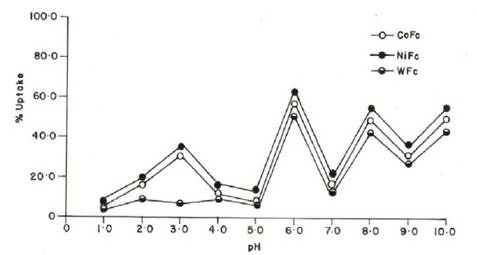
Fig. 1 Effect of pH on adsorption of 2-nitrophenol on metal ferrocyanides. Temperature = 30 ± 1 ° C; pH = 1.0-10.0 ± 0.01; amount of metal ferrocyanide = 25 mg; particle size = 125 µm; λmax 2-nitrophenol = 360 nm; CoFc = cobalt ferrocyanide ; NiFc = nickel ferrocyanide ; WFc= tungsten ferrocyanide .
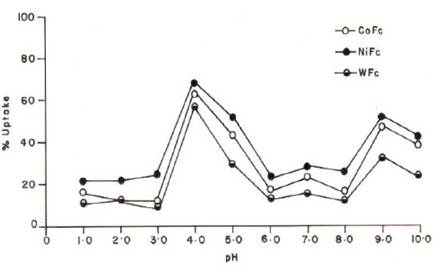
Fig. 2 Effect of pH on adsorption of 2,4- dinitrophenol on metal ferrocyanides. Temperature = 30 ± 1° C; pH = 1.0-10.0 ± 0.01; amount of metal ferrocyanide = 25 mg; particle size = 125 µm; λmax 2, 4 - dinitrophenol = 360 nm; CoFc= cobalt ferrocyanide; NiFc= nickel ferrocyanide ; WFc= tungsten ferrocyanide .
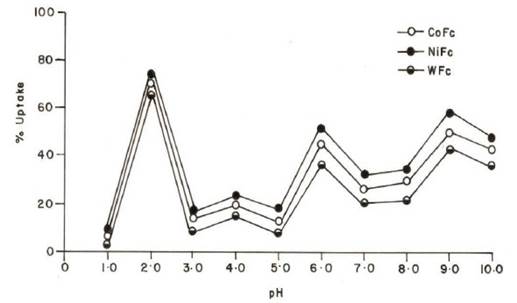
Fig. 3 Effect of pH on adsorption of 2,4,6-trinitrophenol on metal ferrocyanides. Temperature = 30 ± 1 ° C; pH = 1.0- 10.0 ± 0.01; amount of metal ferrocyanide = 25 mg; particle size = 125 µm; λmax 2, 4, 6 - trinitrophenol = 382 nm; CoFc= cobalt ferrocyanide; NiFc= nickel ferrocyanide ; WFc= tungsten ferrocyanide .
Table 1 Elemental analysis of cobalt, nickel and tungsten ferrocyanides. Note. CoFc: cobalt ferrocyanides; NiFc: nickel ferrocyanide; WFc: tungsten ferrocyanide.
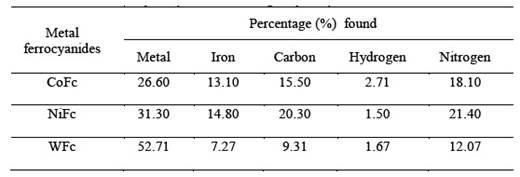
Table 2 Infrared spectral data of cobalt, nickel and tungsten ferrocyanides. * Metal - N band shows degree of polymerization; CoFc= cobalt ferrocyanide; NiFc= nickel ferrocyanide ; WFc= tungsten ferrocyanide .
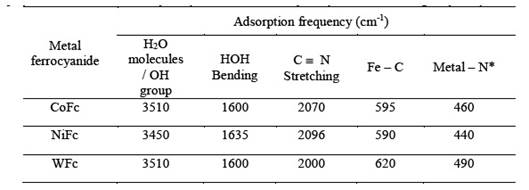
The adsorption of 2-NP (pKa = 7.17), 2,4-DNP (pKa = 3.96) and 2,4,6-TNP (pKa = 0.38) were found to be maximum near to their respective pKa values. pH was maintained as desired by using dilute HCl or NaOH Solutions. The percentage uptake of 2-NP, 2, 4-DNP and 2,4,6-TNP on cobalt, nickel and tungsten ferrocyanides are given in Tables 3, 4 and 5, respectively.
Table 3 Percentage adsorption of 2 - nitrophenol on metal ferrocyanides. Note. Room temperature = 30 ± 1º C; amount of metal ferrocyanide = 25 mg: λmax 2-nitrophenol = 360 nm; 2-nitrophenol pKa = 7.17.

Table 4 Percentage adsorption of 2, 4 - dinitrophenol on metal ferrocyanides. Note. Room temperature = 30 ± 1º C; amount of metal ferrocyanide = 25 mg; λmax 2,4-dinitrophenol = 360 nm; 2,4-dinitrophenol pKa = 3.96.
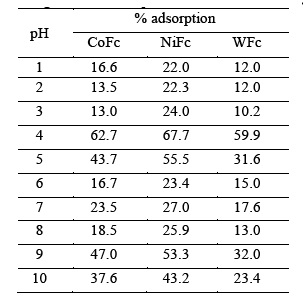
Table 5 Percentage adsorption of 2,4,6-trinitrophenol on metal ferrocyanides. Note: Room temperature = 30 ± 1º C; amount of metal ferrocyanide = 25 mg; λmax 2,4,6-trinitrophenol = 382 nm; 2,4,6-trinitrophenol pKa = 0.38.
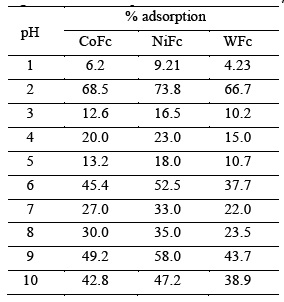
The uptake percentage was calculated by the general formula:
It is observed from Tables 3, 4 and 5 that 2-NP, 2,4-DNP and 2,4,6-TNP have maximum adsorption at pHs 6.0, 4.0 and 2.0, respectively with all three metal ferrocyanides studied. It is also observed from Tables 3, 4 and 5 that 2,4,6-TNP and 2-NP has maximum and minimum adsorption, respectively with all three adsorbents.
Electron density of aromatic ring is strongly influenced by the nature and number of substituent present in it. The nitro group is electron withdrawing and reduces the overall electron density in the pi system of benzene ring. The nature of substituent is similar in all three adsorbates. The maximum and minimum adsorption in case of 2,4,6-TNP and 2-NP is only due to various number of substituent groups. The minimum adsorption in case of 2-NP is also may be due to the presence of intermolecular hydrogen bonding between ortho nitro and phenolic hydroxyl groups. The adsorption of substituted phenols on metal ferrocyanides may be due to presence of phenolic hydroxyl group, nitro group and benzene ring in substituted phenol molecule, which act as a site for interaction with metal ferrocyanides surface 41.
Effect of concentration on adsorption of substituted phenols on metal ferrocyanides
A neutral pH (7.0 ± 0.01) and room temperature 30 ± 1 ºC was chosen to run the adsorption of 2-NP, 2,4-DNP and 2,4,6-TNP in wide concentration range. The neutral pH is physiologically significant, as most of the reactions in living systems take place in neutral medium. The desired pH was maintained by dilute NaOH or HCl solutions. The adsorption isotherms as phenol concentration versus amount adsorbed (mg / g) for adsorption of 2-NP, 2,4-DNP and 2,4,6-TNP on cobalt, nickel and tungsten ferrocyanides are shown in Figures 4, 5 & 6, respectively.

Fig. 4 Adsorption isotherms of 2-nitrophenol on metal ferrocyanides. Temperature = 30 ± 1 ° C; pH = 7.0 ± 0.01; amount of metal ferrocyanide = 25 mg; particle size = 125 µm; λ max 2 - nitrophenol = 360 nm; CoFc = cobalt ferrocyanide; NiFc = nickel ferrocyanide ; WFc= tungsten ferrocyanide .

Fig. 5 Adsorption isotherms of 2,4-dinitrophenol on metal ferrocyanides. Temperature = 30 ± 1 ° C; pH = 7.0 ± 0.01; amount of metal ferrocyanide = 25 mg; particle size = 125 µm; λmax 2, 4-dinitrophenol = 360 nm; CoFc = cobalt ferrocyanide; NiFc = nickel ferrocyanide ; WFc= tungsten ferrocyanide .
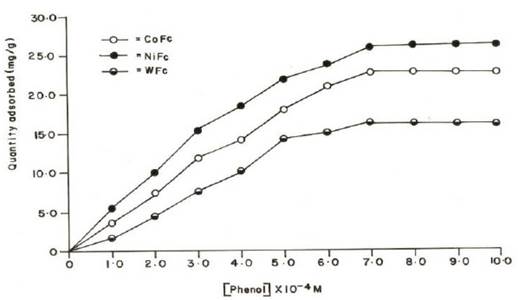
Fig. 6 Adsorption isotherms of 2,4,6-trinitrophenol on metal ferrocyanides. Temperature = 30 ± 1 ° C; pH = 7.0 ± 0.01; amount of metal ferrocyanide = 25 mg; particle size = 125 µm; λmax 2, 4, 6-trinitrophenol= 382 nm; CoFc = cobalt ferrocyanide; NiFc = nickel ferrocyanide; WFc= tungsten ferrocyanide.
Adsorption isotherms of 2-NP, 2,4-DNP and 2,4,6-TNP on metal ferrocyanides show that adsorption is fast in all cases, isotherms are regular, positive and concave to the concentration axis. Slow adsorption gradually leading to constancy takes place at higher adsorbate concentration. In general, the adsorption curves were characterized by a gradual rise and a flattering at higher adsorbate concentrations. The result is that affinity of metal ferrocyanides toward adsorption for 2-NP, 2,4-DNP and 2,4,6-TNP follow the order
Nickel ferrocyanide > cobalt ferrocyanide > tungsten ferrocyanide
Present trend is verified by considering the adsorption to be directly proportional to the specific surface area of metal ferrocyanides. Specific surface area of metal ferrocyanides was determined by basic methylene blue dye adsorption. Nickel, cobalt and tungsten ferrocyanides (125 µm particle size) were found to have specific surface area 82.17, 71.33 and 26.33 m2g-1, respectively at room temperature 30 ±1 o C.
The present results also suggest that affinity of substituted phenols with cobalt, nickel and tungsten ferrocyanides follow the order.
2, 4, 6-Trinitrophenol > 2, 4-dinitrophenol > 2-nitrophenol
Langmuir plots (1/Ceq (equilibrium concentration of solute in solution) versus 1/Qeq (amount of solute adsorbed per unit mass of adsorbent) ) for adsorption of 2-NP, 2,4-DNP and 2,4,6-TNP on cobalt, nickel and tungsten ferrocyanides are shown in Figures 7, 8 & 9, respectively. Linear nature of plots shows the Langmuir type of adsorption in general.
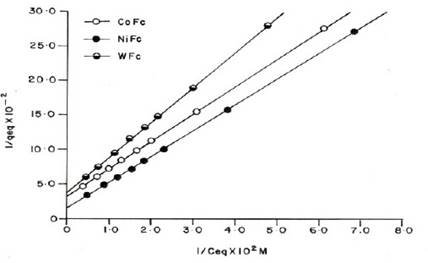
Fig. 7 Langmuir plots of 2-nitrophenol on metal ferrocyanides. Temperature = 30 ± 1 º C; pH = 7.0 ± 0.01; amount of metal ferrocyanide = 25 mg; particle size = 125 µm; λmax 2-nitrophenol = 360 nm; CoFc = cobalt ferrocyanid; NiFc = nickel ferrocyanide ; WFc= tungsten ferrocyanide .

Fig. 8 Langmuir plots of 2,4-dinitrophenol on metal ferrocyanides. Temperature = 30 ± 1 °C; pH = 7.0 ± 0.01; amount of metal ferrocyanide = 25 mg; particle size = 125 µm; λmax 2, 4-dinitrophenol = 360 nm; CoFc = cobalt ferrocyanide; NiFc = nickel ferrocyanide ; WFc= tungsten ferrocyanide .
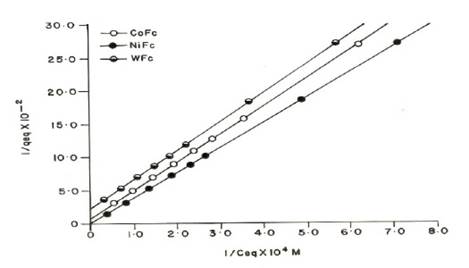
Fig.9. Langmuir plots of 2,4,6-trinitrophenol on metal ferrocyanides. Temperature = 30 ± 1 ° C; pH = 7.0 ± 0.01; amount of metal ferrocyanide = 25 mg; particle size = 125 µm; λmax 2,4,6-trinitrophenol = 382 nm; CoFc = cobalt ferrocyanide ; NiFc = nickel ferrocyanide ; WFc= tungsten ferrocyanide .
Langmuir plots exhibit the amount of substituted phenols adsorbed as a function of their equilibrium concentration. The trends of substituted phenols’ adsorption on metal ferrocyanides follow the Langmuir equation 42.
where Qeq is the amount of solute adsorbed per unit mass of adsorbent, Ceq the equilibrium concentration of solute in solution, Q0 the limiting amount of adsorbate that can be taken up by unit mass of adsorbent, b the constant related to equilibrium constant or bonding energy or enthalpy ( ΔH) of adsorption (b α e - ΔH/RT, the parameter b reflects the steepness of the approach to saturation; more precisely, the b value is the reciprocal of concentration at which half of the saturation of the adsorbent is attained). Actually, b is a constant, which is function of adsorption energy. The appropriate Langmuir constants b and Q0 were calculated from the slope and intercept of Langmuir plots, respectively. The values of Langmuir constants are given in Table 6.
Table 6 Langmuir constants for adsorption of 2-nitrophenol, 2, 4-dinitrophenol and 2,4,6-trinitrophenol on metal ferrocyanides. Note. Room temperature = 30 ± 1º C; pH 7.0 ± 0.01; amount of metal ferrocyanide = 25 mg; λmax 2-nitrophenol = 360 nm; λmax 2,4-dinitrophenol = 360 nm; λmax 2,4,6-trinitrophenol = 382 nm.

The general formula of metal hexacyanoferrate (II) is M2 [Fe (CN) 6], where M represents a transition metal ion. The M2+ ions are exchangeable cations, species [Fe (CN) 6]4- in metal hexacyanoferrate (II) exist with an octahedral geometry, where six CN- ligands surround the central iron atom 43. Due to strong field of the CN- ligand, all six electrons become paired to give the electronic configuration t2g 6. Although the CN- ligand bound with Fe via 6 donations, there is sufficient back bonding from iron metal dπ orbitals to the CN- ligand antibonding pπ orbitals.
Transition metal hexacyanoferrate (II) complexes usually have a polymeric lattice structure with [Fe (CN)6]4- anions, where the outer transition - metal ion may be coordinated through the nitrogen end of the cyanide ligand. The adsorption of substituted phenols on metal hexacyanoferrate (II) is probable due to a substituted phenol interaction with the replaceable divalent metal ions present outside of the coordination sphere of the hexacyanoferrate (II).
The parallel studies in the adsorptive interaction of phenols with various surfaces has been reported in the chemical literature. Removal of polyphenol from crude olive mill wastewaters through adsorption on crude olive stone is reported by Allaoui et al. 44 . Hariyani et al. 45 has studied adsorption of phenols from aqueous solution on hydroxyapatite-PEG/Fe3O4 composite. Thermodynamic studies on the adsorption of phenol from aqueous solution by coffee husk activated carbon is investigated by Ta et al. 46. Eder et al. 47 has investigated mass transfer mechanism and equilibrium modelling of hydroxytyrosol adsorption on olive pit-derived activated carbon. Phenols removal from water stream through adsorption on activated carbon prepared from food waste described by Yu et al. 48.Amar et al. 49 has studied adsorption of phenols on regional clay. Adsorptive removal of 3, 4- dichlorophenol from aqueous solution by using used black tea leaves studied by Ahmad and Rahman 50. Ho and Adnan 51 has investigated removal of phenol from aqueous solution using coconut shell activated carbon.
CONCLUSION
The present research work has shown that metal ferrocyanides to be reasonable and plausible candidates in studies involving adsorption and removal of phenolic compounds from aqueous solution and waste water. Metal hexacyanoferrate (II) complexes can be used for the removal of phenolic contaminants from agricultural soil and environment. The result on the present studies also show that the adsorption of substituted phenols on metal ferrocyanides is quite satisfactory. The most effective pH for the removal of 2-NP, 2,4-DNP and 2,4,6-TNP is found to be 6.0, 4.0 and 2.0, respectively. The adsorbents may be useful for the treatment of phenol bearing wastewater.
EXPERIMENTAL
Chemicals
Potassium ferrocyanide, cobalt (II) chloride, sodium tungstate, nickel (II) chloride, 2-nitrophenol, 2,4-dinitrophenol and 2,4,6-trinitrophenol, were obtained from BDH, Poole, UK. All chemicals were of Analytical Reagent grade and used without further purification. Solutions were prepared in double distilled water.
Synthesis of metal ferrocyanides
Nickel ferrocyanide was prepared by adding nickel chloride (500 mL; 0.1 M) to potassium ferrocyanide (167 mL; 0.1 M) solution with constant stirring 52. The reaction mixture was heated on a water bath for 3 h and kept as such at room temperature for 24 h. The precipitate was filtered under vacuum, washed several times with distilled water and dried in an air oven at 60º C. The dried product was grounded and sieved to 125 µm particle size.
Cobalt ferrocyanide was synthesized by adding (1 Volume, 0.5 M) potassium ferrocyanide and (2.4 Volume, 0.3 M) cobalt chloride and kept as such after gentle stirring over a period of 0.5 h at room temperature 53. The slurry of cobalt ferrocyanide was filtered under vacuum, washed several times with distilled water and dried. The resulting granules were dried and powdered to 125 µm particle size.
Tungsten ferrocyanide was prepared by adding potassium ferrocyanide (0.1 M, 200 mL) sodium tungstate (0.1 M, 400 mL) and HCl (1.0 M, 10 mL) with constant stirring 54. The reaction mixture was then heated in a boiling water bath for 3 h. The product was left at room temperature for 24 h. The precipitate was then filtered under vacuum, washed with distilled water and dried in an oven at 60º C. The dried product was ground and sieved to desired mesh size.
Stability of metal ferrocyanides
Cobalt, nickel and tungsten ferrocyanides are amorphous solid and not showed and x-ray pattern on XRD study. Stability of cobalt, nickel and tungsten ferrocyanides was checked by placing 20 mg of each metal ferrocyanide in the test tube containing 10 ML of each acids , bases and salt solutions The mixture was agitated for 20 minutes at room temperature and stability was checked by observation in any change in colour of metal ferrocyanides.
All three metal ferrocyanides are found to be stable in acids (HCl, HNO3, H2SO4, CH3COOH) and bases (NaOH, KOH, NH4OH) in the concentration range 0.1 - 2.0 M. Metal ferrocyanides are also found to be stable in salts (NaCl, KCl, LiCl, NH4Cl, RbCl, CsCl, BaCl2, CaCl2, MgCl2) solution in the concentration range 1.0 - 2.0 M.
Elemental studies of metal ferrocyanides
Cobalt, nickel, tungsten hexacyanoferrate (II) complexes were characterized on the basis of elemental analysis. Cobalt, nickel, tungsten and iron were estimated by atomic absorption spectrophotometry on IL - 751 Spectrophotometer 55. Carbon, hydrogen, nitrogen analysis was performed on CEST - 118, CHN analyzer (Table 1).
Spectral studies of metal ferrocyanides
Infrared spectra of the metal ferrocyanides were recorded in KBr disc on Beckman IR - 20 Spectrophotometer. Cobalt, nickel and tungsten ferrocyanides revealed peaks around 3500 and 1600 cm-1 characteristic of water molecules / OH group and HOH bending, respectively. Two sharp bands at around 2070 cm-1 and 595 cm-1 are characteristics of cyanide and Fe - C stretching, respectively [56]. Another sharp band at 460 cm-1 probably shows the presence of a metal - nitrogen band due to polymerization 57 (Table 2).
Adsorption studies
Effect of pH on adsorption of phenols on metal ferrocyanides
The adsorption of substituted phenols on metal ferrocyanides at different pH (1.0 - 10.0) and 1 x 10-4 M adsorbate concentration was studied. A series of 15 mL test tubes were employed. Each tube was filled with 10 mL of substituted phenol solutions and adjusted to desired pH. The desired pH was maintained by dilute NaOH or HCl solutions. A 25 mg of metal ferrocyanide was added into each tube at room temperature (30 ± 1º C) and agitated for 6 h until equilibrium was attained. The equilibrium time and concentration range were, however, decided after a good deal of preliminary investigations. The content then centrifuged, decanted and concentration of supernatant was measured spectrophotometrically using the Uvikon spectrophotomer (No. 922 Kontrom Instruments). The concentration of 2-NP, 2,4-DNP and 2,4,6-TNP were measured spectrophotometrically at 360, 360 and 382 nm, respectively. The amount of substituted phenols absorbed calculated by the difference in concentration before and after the adsorption.
Effect of concentration on adsorption of substituted phenols on metal ferrocyanides
The adsorption of 2-NP, 2,4-DNP and 2,4,6-TNP on metal ferrocyanides as a function of substituted phenols concentrated (10-3 - 10-4 M) was studied at pH 7.0 ± 0.01 and room temperature 30 ± 1º C. A number of 15 mL test tubes were filled with 10 mL of phenol solution and adjusted to desired pH, sample of 25 mg of metal ferrocyanides was added to each test tube and stoppered. The tubes were agitated for 6 h until equilibrium was attained. The content then centrifuged, decanted and adsorption of 2-NP, 2,4-DNP and 2,4,6-TNP was measured spectrophotometrically at their corresponding λmax 360, 360 and 382 nm, respectively.












 uBio
uBio 



